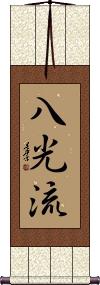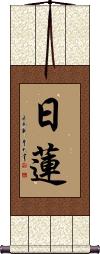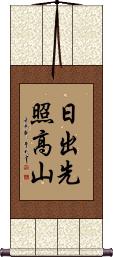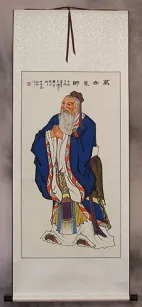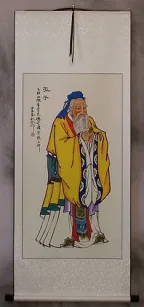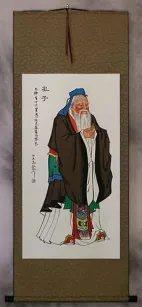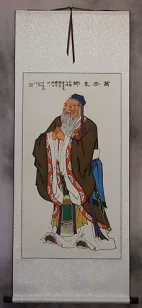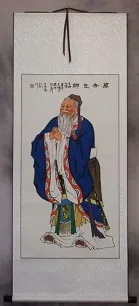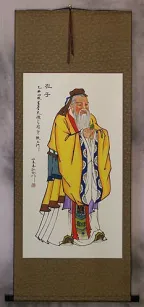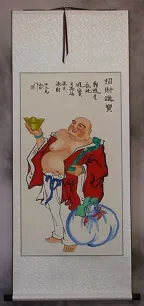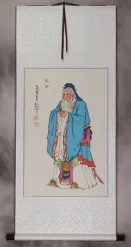Many custom options...
And formats...

Not what you want?
Try other similar-meaning words, fewer words, or just one word.
Great Light in Chinese / Japanese...
Buy a Great Light calligraphy wall scroll here!
Personalize your custom “Great Light” project by clicking the button next to your favorite “Great Light” title below...
1. Light / Bright and Promising Future
2. Bright and Promising Future
3. Hakko-Ryu
6. Nichiren
7. When the sun rises it first shines on the highest mountain
Light / Bright and Promising Future
光明 is a nice way to say “light” in Chinese and old Korean Hanja.
This is because the word also suggests a bright future or refers to someone who is very promising (great future potential).
The first character means light or bright.
The second character means bright and clear (in this context).
This word appears in most Japanese dictionaries, but it is not the most common Japanese Kanji word for light (more commonly used for the name Mitsuharu).
In old Korean Hanja, this can also mean brightness or brilliance.
In the context of Buddhism, this means “Light emanating from a Buddha or Bodhisattva, symbolizing their wisdom and compassion.”
Bright and Promising Future
明るい未来 is a Japanese proverb that means “Bright Future.”
It suggests a lot of possibilities and potential awaits in your future. A great gift for a graduate.
The first part of this proverb literally means bright or light. The second part means the future but can also be translated as “the world to come.”
Note: Because this selection contains some special Japanese Hiragana characters, it should be written by a Japanese calligrapher.
Hakko-Ryu
八光流 (Hakkō-Ryū) is a style of jujutsu associated with Daito-Ryu.
The title Hakko-Ryu comes from the Japanese phrase which translates as “The Style of the Eighth Light,” or more literally, “Eighth Light Style.”
The 光 character is associated with brightness or brilliance. It can be used to describe someone of great talent or potential. So the meaning goes far beyond just light.
Shiken Haramitsu Daikomyo
四拳波羅蜜大光明 is “shiken haramitsu daikōmyō,” a famous Japanese Buddhist mantra.
四拳 = shi-ken = four fists (many translate this as “four hearts”).
波羅蜜 = ha-ra-mitsu = A loanword representing pāramitā, or entrance into Nirvana. Awkwardly, it also means jackfruit.
大光明 = dai-kou-myo = big/great light bright (great bright light).
Shiken represents four hearts:
1. The Merciful Heart - Love and caring for all living things.
2. The Sincere Heart - Pursues righteousness, or the right path - sincerely trying to do what is right.
3. The Attuned Heart - Knows that nature and fate have their ways, and thus stay in tune with the universe.
4. The Dedicated Heart - Steadfast on the chosen path to the end.
Reiki - Master Symbol
大光明 is the master symbol “Daikomyo” or “Dai Ko Myo,” which is usually associated with the healing practice of Reiki.
This title can be translated as “Great Bright Light.” This symbol, as used in Reiki, alludes to “Enlightened Nature” or the radiance of a purified soul or deity.
Pronunciations in Chinese and Korean are included above but this title has no meaning except when used by a Reiki practitioner. In fact, this title is not that well known by those outside the Reiki community in Japan.
In Chinese, this would be interpreted as “Great Bright Future” (the second two characters alone create a word that means “bright future” in Chinese).
Nichiren
日蓮 is the title Nichiren.
This title refers to a Buddhist priest who lived from 1222 to 1282. He is the founder of the Nichiren sect of Buddhism.
According to historical documents, the Nichiren sect was established in 1252. Adding the character 宗 for sect, this would be 日蓮宗 (Nichiren sect), which is also known as the 法華宗 or Lotus sect.
According to Soothill-Hodous...
Nichiren's chief tenets are the three great mysteries 三大祕法, representing the trikāya:
1. 本尊 or chief object of worship, being the great maṇḍala of the worlds of the ten directions, or universe, i.e., the body or nirmāṇakāya of Buddha.
2. 題目 the title of the Lotus Sutra 妙法蓮華經 Myo-ho-ren-ge-kyo, preceded by Namo, or “Adoration to the scripture of the lotus of the wonderful law,” for it is Buddha's spiritual body.
3. 戒壇 the altar of the law, which is also the title of the Lotus as above; the believer, wherever he is, dwells in the Pure-land of calm light 寂光淨土, the saṃbhogakāya.
When the sun rises it first shines on the highest mountain
This old Buddhist phrase means, “When the sun rises it always shines first on the highest mountain,” or “When the sun appears, it first casts its light upon the highest mountain.”
This comes from the Avatamsaka Sutra and has been used as the name or portion of the name for temples in Japan and sites in China.
The Buddha's first round of teaching (Avatamsaka period) is likened to the time when the sun rises from the east horizon. When the sun first rises it illuminates the high mountains. In this analogy, the high mountains represent the great Bodhisattvas and/or those most ready to receive enlightenment and liberation.
This can be romanized from Japanese as “Nichi shutsu sen shō kō san,” “Nisshutsu saki teru takayama,” or “Hide temazu kōzan wo terasu yama.” The last one is probably the most common. Ask three Japanese people what they think the pronunciation is, and you will get three different opinions.
This in-stock artwork might be what you are looking for, and ships right away...
Gallery Price: $220.00
Your Price: $79.88
Gallery Price: $126.00
Your Price: $69.88
Gallery Price: $71.00
Your Price: $39.00
Not the results for great light that you were looking for?
Below are some entries from our dictionary that may match your great light search...
| Characters If shown, 2nd row is Simp. Chinese |
Pronunciation Romanization |
Simple Dictionary Definition |
日蓮 日莲 see styles |
rì lián ri4 lian2 jih lien nichiren にちれん |
More info & calligraphy: NichirenNichiren, the Japanese founder, in A. D. 1252, of the 日蓮宗 Nichiren sect, which is also known as the 法華宗 or Lotus sect. Its chief tenets are the three great mysteries 三大祕法, representing the trikāya: (1) 本尊 or chief object of worship, being the great maṇḍala of the worlds of the ten directions, or universe, i. e. the body or nirmāṇakāya of Buddha; (2) 題目 the title of the Lotus Sutra 妙法蓮華經 Myo-ho-ren-gwe-kyo, preceded by Namo, or, 'Adoration to the scripture of the lotus of the wonderful law, ' for it is Buddha's spiritual body; (3) 戒壇 the altar of the law, which is also the title of the Lotus as above; the believer, wherever he is, dwells in the Pure-land of calm light 寂光淨土, the saṃbhogakāya. |
千種 see styles |
chidane ちだね |
(1) great variety of flowering plants; (2) (abbreviation) light greenish-blue; (adj-na,adj-no,n) (3) various; (surname) Chidane |
千草 see styles |
chigusa ちぐさ |
(1) great variety of flowering plants; (2) (abbreviation) light greenish-blue; (surname, female given name) Chigusa |
四禪 四禅 see styles |
sì chán si4 chan2 ssu ch`an ssu chan shizen |
(四禪天) The four dhyāna heavens, 四靜慮 (四靜慮天), i. e. the division of the eighteen brahmalokas into four dhyānas: the disciple attains to one of these heavens according to the dhyāna he observes: (1) 初禪天 The first region, 'as large as one whole universe' comprises the three heavens, Brahma-pāriṣadya, Brahma-purohita, and Mahābrahma, 梵輔, 梵衆, and 大梵天; the inhabitants are without gustatory or olfactory organs, not needing food, but possess the other four of the six organs. (2) 二禪天 The second region, equal to 'a small chiliocosmos' 小千界, comprises the three heavens, according to Eitel, 'Parīttābha, Apramāṇābha, and Ābhāsvara, ' i. e. 少光 minor light, 無量光 infinite light, and 極光淨 utmost light purity; the inhabitants have ceased to require the five physical organs, possessing only the organ of mind. (3) 三禪天 The third region, equal to 'a middling chiliocosmos '中千界, comprises three heavens; Eitel gives them as Parīttaśubha, Apramāṇaśubha, and Śubhakṛtsna, i. e. 少淨 minor purity, 無量淨 infinite purity, and 徧淨 universal purity; the inhabitants still have the organ of mind and are receptive of great joy. (4) 四禪天 The fourth region, equal to a great chiliocosmos, 大千界, comprises the remaining nine brahmalokas, namely, Puṇyaprasava, Anabhraka, Bṛhatphala, Asañjñisattva, Avṛha, Atapa, Sudṛśa, Sudarśana, and Akaniṣṭha (Eitel). The Chinese titles are 福生 felicitous birth, 無雲 cloudless, 廣果 large fruitage, 無煩 no vexations, atapa is 無熱 no heat, sudṛśa is 善見 beautiful to see, sudarśana is 善現 beautiful appearing, two others are 色究竟 the end of form, and 無想天 the heaven above thought, but it is difficult to trace avṛha and akaniṣṭha; the inhabitants of this fourth region still have mind. The number of the dhyāna heavens differs; the Sarvāstivādins say 16, the 經 or Sutra school 17, and the Sthavirāḥ school 18. Eitel points out that the first dhyāna has one world with one moon, one mem, four continents, and six devalokas; the second dhyāna has 1, 000 times the worlds of the first; the third has 1, 000 times the worlds of the second; the fourth dhyāna has 1, 000 times those of the third. Within a kalpa of destruction 壞劫 the first is destroyed fifty-six times by fire, the second seven by water, the third once by wind, the fourth 'corresponding to a state of absolute indifference' remains 'untouched' by all the other evolutions; when 'fate (天命) comes to an end then the fourth dhyāna may come to an end too, but not sooner'. |
大刧 大劫 see styles |
dà jié da4 jie2 ta chieh daikō |
mahākalpa. The great kalpa, from the beginning of a universe till it is destroyed and another begins in its place. It has four kalpas or periods known as vivarta 成刧 the creation period; vivarta‐siddha 住刧 the appearance of sun and moon, i.e. light, and the period of life, human and general; saṃvarta 壤刧 or 滅刧 destruction first by fire, then water, then fire, then deluge, then a great wind, i.e. water during seven small kalpas, fire during 56 and wind one, in all 64; saṃvartatthāhi 増滅刧 total destruction gradually reaching the void. A great kalpa is calculated as eighty small kalpas and to last 1,347,000,000 years. |
娑婆 see styles |
suō pó suo1 po2 so p`o so po shaba; shaba しゃば; シャバ |
(1) this world; this life; (2) (kana only) (colloquialism) the free world (outside of prison, the army, red light district, etc.); (3) {Buddh} this corrupt world; present world sahā; that which bears, the earth, v. 地; intp. as bearing, enduring; the place of good and evil; a universe, or great chiliocosm, Where all are subject to transmigration and which a Buddha transforms; it is divided into three regions 三界 and Mahābrahmā Sahāmpati is its lord. Other forms: 娑婆世界; 娑界; 娑媻; 娑訶; 沙訶; 索訶. |
六觀音 六观音 see styles |
liù guān yīn liu4 guan1 yin1 liu kuan yin Rokkannon |
The six kinds of Guanyin. There are two groups— I. That of Tiantai: 大悲 most pitiful; 大慈 most merciful; 師子無畏 of lion-courage; 大光普照 of universal light; 天人丈夫 leader amongst gods and men; 大梵深遠 the great omnipresent Brahma. Each of this bodhisattva's six qualities of pity, etc., breaks the hindrances 三障 respectively of the hells, pretas, animals, asuras, men, and devas. II. As thousand-handed; the holy one; horseheaded; eleven-faced; Cundī (or Marīci); with the wheel of sovereign power. |
須摩那 须摩那 see styles |
xū mó nà xu1 mo2 na4 hsü mo na |
Sumanā, also 修摩那 (or 蘇摩那); 須曼那; a plant 4 or 5 feet high with light yellow flowers, the 'great flowered jasmine'. M.W. |
大光明王 see styles |
dà guāng míng wáng da4 guang1 ming2 wang2 ta kuang ming wang Dai kōmyō ō |
The Great-Light Ming-wang, Śākyamuni in a previous existence, when king of Jambudvīpa, at Benares. There his white elephant, stirred by the sight of a female elephant, ran away with him into the forest, where he rebuked his mahout, who replied, "I can only control the body not the mind, only a Buddha can control the mind." Thereupon the royal rider made his resolve to attain bodhi and become a Buddha. Later, he gave to all that asked, finally even his own head to a Brahman who demanded it, at the instigation of an enemy king. |
大光普照 see styles |
dà guāng pǔ zhào da4 guang1 pu3 zhao4 ta kuang p`u chao ta kuang pu chao daikō fushō |
The great light shining everywhere, especially the ray of light that streamed from between the Buddha's eyebrows, referred to in the Lotus Sutra. |
大熾盛光 大炽盛光 see styles |
dà chì shèng guāng da4 chi4 sheng4 guang1 ta ch`ih sheng kuang ta chih sheng kuang dai shijō kō |
The great blazing perfect light, a title of 金輪佛頂尊. |
毘盧舍那 毘卢舍那 see styles |
pí lú shèn à pi2 lu2 shen4 a4 p`i lu shen a pi lu shen a Birushana |
Vairocana, 'belonging to or coming from the sun' (M. W.), i. e. light. The 眞身 q. v. true or real Buddha-body, e. g. godhead. There are different definitions. Tiantai says Vairocana represents the 法身 dharmakāya, Rocana or Locana the 報身 saṃbhogakāya, Śākyamuni the 應身 nirmāṇakāya. Vairocana is generally recognized as the spiritual or essential body of Buddha-truth, and like light 徧一切處 pervading everywhere. The esoteric school intp. it by the sun, or its light, and take the sun as symbol. It has also been intp. by 淨滿 purity and fullness, or fullness of purity. Vairocana is the chief of the Five dhyāni Buddhas, occupying the central position; and is the 大日如來 Great Sun Tathāgata. There are numerous treatises on the subject. Other forms are 毘盧; 毘盧遮那 (or 毘盧折那); 吠嚧遮那; 鞞嚧杜那. |
Variations: |
chigusa; chikusa ちぐさ; ちくさ |
(1) great variety of flowering plants; (2) (abbreviation) (See 千草色) light greenish-blue; (adj-na,adj-no,n) (3) (千種 only) various |
大智慧光明義 大智慧光明义 see styles |
dà zhì huì guāng míng yì da4 zhi4 hui4 guang1 ming2 yi4 ta chih hui kuang ming i dai chie kōmyō gi |
meaning of a bright light of great wisdom |
藥王十二誓願 药王十二誓愿 see styles |
yào wáng shí èr shì yuàn yao4 wang2 shi2 er4 shi4 yuan4 yao wang shih erh shih yüan yakuō jūni seigan |
The twelve vows of the Buddha of Medicine are: (1) To shine upon all beings with his light; (2) to reveal his great power to all beings; (3) to fulfil the desires of all beings; (4) to cause all beings to enter the Great Vehicle; (5) to enable all beings to observe all the moral laws; (6) to heal all those whose senses are imperfect; (7) to remove all diseases and give perfect health of body and mind and bring all to perfect enlightenment; (8) to transform women into men (in the next rebirth); (9) to enable all beings to escape false doctrines and bonds and attain to truth; (10) to enable all beings to escape evil kalpas, etc.; (11) to give superior food to the hungry; (12) and wonderful garments to the naked. |
不空羂索毘盧遮那佛大灌頂光眞言 不空羂索毘卢遮那佛大灌顶光眞言 see styles |
bù kōng juàn suǒ pí lú zhēn à fó dà guàn dǐng guāng zhēn yán bu4 kong1 juan4 suo3 pi2 lu2 zhen1 a4 fo2 da4 guan4 ding3 guang1 zhen1 yan2 pu k`ung chüan so p`i lu chen a fo ta kuan ting kuang chen yen pu kung chüan so pi lu chen a fo ta kuan ting kuang chen yen Fukū kenjaku Birushana butsu daikanjō kōshingon |
Light Mantra of the Great Consecration of the Infallible Lasso Vairocana |
大佛頂如來放光悉憺多鉢憺陀羅尼 大佛顶如来放光悉憺多钵憺陀罗尼 see styles |
dà fó dǐng rú lái fàng guāng xī dá duō bō dá luó tuó luó ní da4 fo2 ding3 ru2 lai2 fang4 guang1 xi1 da2 duo1 bo1 da2 luo2 tuo2 luo2 ni2 ta fo ting ju lai fang kuang hsi ta to po ta lo t`o lo ni ta fo ting ju lai fang kuang hsi ta to po ta lo to lo ni Dai bucchō nyorai hōkō Shittatahattara darani |
Dhāraṇī of Śitātapatra, Great Corona of All Tathāgatas, Radiating Light [The Great Queen of Vidyā called Aparājitā] |
The following table may be helpful for those studying Chinese or Japanese...
| Title | Characters | Romaji (Romanized Japanese) | Various forms of Romanized Chinese | |
| Light Bright and Promising Future | 光明 | kou mei / mitsu haru koumei / mitsuharu ko mei / mitsu haru | guāng míng guang1 ming2 guang ming guangming | kuang ming kuangming |
| Bright and Promising Future | 明るい未来 | akarui mirai akaruimirai | ||
| Hakko-Ryu | 八光流 | hakkou ryuu hakkouryuu hako ryu | ||
| Shiken Haramitsu Daikomyo | 四拳波羅蜜大光明 | shi ken ha ra mitsu dai kou myou shi ken ha ra mitsu dai ko myo | ||
| Reiki - Master Symbol | 大光明 | dai kou myou daikoumyou dai ko myo | dà guāng míng da4 guang1 ming2 da guang ming daguangming | ta kuang ming takuangming |
| Nichiren | 日蓮 日莲 | nichi ren / nichiren | rì lián / ri4 lian2 / ri lian / rilian | jih lien / jihlien |
| When the sun rises it first shines on the highest mountain | 日出先照高山 | hiide temazu kousan wo terasu yama hide temazu kosan wo terasu yama | rì chū xiān zhào gāo shān ri4 chu1 xian1 zhao4 gao1 shan1 ri chu xian zhao gao shan richuxianzhaogaoshan | jih ch`u hsien chao kao shan jihchuhsienchaokaoshan jih chu hsien chao kao shan |
| In some entries above you will see that characters have different versions above and below a line. In these cases, the characters above the line are Traditional Chinese, while the ones below are Simplified Chinese. | ||||
Successful Chinese Character and Japanese Kanji calligraphy searches within the last few hours...


